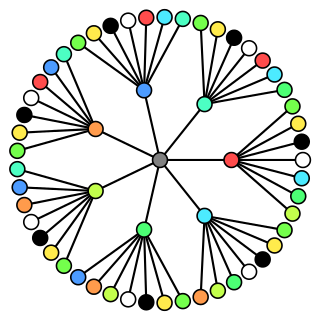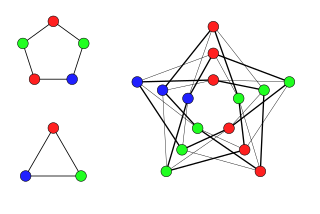Related Research Articles
This is a glossary of graph theory. Graph theory is the study of graphs, systems of nodes or vertices connected in pairs by lines or edges.

In graph theory, graph coloring is a special case of graph labeling; it is an assignment of labels traditionally called "colors" to elements of a graph subject to certain constraints. In its simplest form, it is a way of coloring the vertices of a graph such that no two adjacent vertices are of the same color; this is called a vertex coloring. Similarly, an edge coloring assigns a color to each edge so that no two adjacent edges are of the same color, and a face coloring of a planar graph assigns a color to each face or region so that no two faces that share a boundary have the same color.

Extremal graph theory is a branch of combinatorics, itself an area of mathematics, that lies at the intersection of extremal combinatorics and graph theory. In essence, extremal graph theory studies how global properties of a graph influence local substructure. Results in extremal graph theory deal with quantitative connections between various graph properties, both global and local, and problems in extremal graph theory can often be formulated as optimization problems: how big or small a parameter of a graph can be, given some constraints that the graph has to satisfy? A graph that is an optimal solution to such an optimization problem is called an extremal graph, and extremal graphs are important objects of study in extremal graph theory.
In graph theory, a uniquely colorable graph is a k-chromatic graph that has only one possible (proper) k-coloring up to permutation of the colors. Equivalently, there is only one way to partition its vertices into k independent sets and there is no way to partition them into k − 1 independent sets.

In graph theory, a proper edge coloring of a graph is an assignment of "colors" to the edges of the graph so that no two incident edges have the same color. For example, the figure to the right shows an edge coloring of a graph by the colors red, blue, and green. Edge colorings are one of several different types of graph coloring. The edge-coloring problem asks whether it is possible to color the edges of a given graph using at most k different colors, for a given value of k, or with the fewest possible colors. The minimum required number of colors for the edges of a given graph is called the chromatic index of the graph. For example, the edges of the graph in the illustration can be colored by three colors but cannot be colored by two colors, so the graph shown has chromatic index three.
In graph theory, a branch of mathematics, list coloring is a type of graph coloring where each vertex can be restricted to a list of allowed colors. It was first studied in the 1970s in independent papers by Vizing and by Erdős, Rubin, and Taylor.

In graph theory, total coloring is a type of graph coloring on the vertices and edges of a graph. When used without any qualification, a total coloring is always assumed to be proper in the sense that no adjacent edges, no adjacent vertices and no edge and either endvertex are assigned the same color. The total chromatic number χ″(G) of a graph G is the fewest colors needed in any total coloring of G.

In graph theory, a harmonious coloring is a (proper) vertex coloring in which every pair of colors appears on at most one pair of adjacent vertices. It is the opposite of the complete coloring, which instead requires every color pairing to occur at least once. The harmonious chromatic numberχH(G) of a graph G is the minimum number of colors needed for any harmonious coloring of G.

In graph theory, an acyclic coloring is a (proper) vertex coloring in which every 2-chromatic subgraph is acyclic. The acyclic chromatic numberA(G) of a graph G is the fewest colors needed in any acyclic coloring of G.
In combinatorics, the Dinitz theorem is a statement about the extension of arrays to partial Latin squares, proposed in 1979 by Jeff Dinitz, and proved in 1994 by Fred Galvin.

In graph theory, the Hadwiger conjecture states that if is loopless and has no minor then its chromatic number satisfies . It is known to be true for . The conjecture is a generalization of the four-color theorem and is considered to be one of the most important and challenging open problems in the field.
In graph theory, Vizing's theorem states that every simple undirected graph may be edge colored using a number of colors that is at most one larger than the maximum degree Δ of the graph. At least Δ colors are always necessary, so the undirected graphs may be partitioned into two classes: "class one" graphs for which Δ colors suffice, and "class two" graphs for which Δ + 1 colors are necessary. A more general version of Vizing's theorem states that every undirected multigraph without loops can be colored with at most Δ+µ colors, where µ is the multiplicity of the multigraph. The theorem is named for Vadim G. Vizing who published it in 1964.

In graph theory, Hedetniemi's conjecture, formulated by Stephen T. Hedetniemi in 1966, concerns the connection between graph coloring and the tensor product of graphs. This conjecture states that
In graph theory, an area of mathematics, an equitable coloring is an assignment of colors to the vertices of an undirected graph, in such a way that
In graph theory, the De Bruijn–Erdős theorem relates graph coloring of an infinite graph to the same problem on its finite subgraphs. It states that, when all finite subgraphs can be colored with colors, the same is true for the whole graph. The theorem was proved by Nicolaas Govert de Bruijn and Paul Erdős, after whom it is named.
In graph theory, a branch of mathematics, the Hajós construction is an operation on graphs named after György Hajós that may be used to construct any critical graph or any graph whose chromatic number is at least some given threshold.
The graph coloring game is a mathematical game related to graph theory. Coloring game problems arose as game-theoretic versions of well-known graph coloring problems. In a coloring game, two players use a given set of colors to construct a coloring of a graph, following specific rules depending on the game we consider. One player tries to successfully complete the coloring of the graph, when the other one tries to prevent him from achieving it.
In graph theory, the act of coloring generally implies the assignment of labels to vertices, edges or faces in a graph. The incidence coloring is a special graph labeling where each incidence of an edge with a vertex is assigned a color under certain constraints.
In graph theory, interval edge coloring is a type of edge coloring in which edges are labeled by the integers in some interval, every integer in the interval is used by at least one edge, and at each vertex the labels that appear on incident edges form a consecutive set of distinct numbers.
Jeannette Catharina Maria Janssen is a Dutch and Canadian mathematician whose research concerns graph theory and the theory of complex networks. She is a professor of mathematics at Dalhousie University, the chair of the Dalhousie Department of Mathematics and Statistics, and the chair of the Activity Group on Discrete Mathematics of the Society for Industrial and Applied Mathematics.
References
- Galvin, Fred (1995), "The list chromatic index of a bipartite multigraph", Journal of Combinatorial Theory , Series B, 63: 153–158, doi: 10.1006/jctb.1995.1011 .
- Jensen, Tommy R.; Toft, Bjarne (1995), "12.20 List-Edge-Chromatic Numbers", Graph Coloring Problems, New York: Wiley-Interscience, pp. 201–202, ISBN 0-471-02865-7 .
- Kahn, Jeff (2000), "Asymptotics of the list chromatic index for multigraphs", Random Structures & Algorithms, 17 (2): 117–156, doi:10.1002/1098-2418(200009)17:2<117::AID-RSA3>3.0.CO;2-9